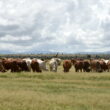 Mastitis affects dairy farms worldwide, leading to decreased milk quality and quantity.
Mastitis affects dairy farms worldwide, leading to decreased milk quality and quantity.
According to Cargill, Bovine mastitis is a condition typified by the persistent and inflammatory reaction of the udder tissue due to either physical trauma or infections caused by microorganisms. It is a potentially fatal mammary gland infection, that is most common in dairy cattle worldwide. It is a disease that is known to cause the greatest loss to the dairy industry.
Cargill provides food, agriculture, financial and industrial products and services worldwide.
Mastitis causes
Mastitis is caused by microorganisms, usually bacteria, that invade the udder, multiply, and produce toxins that are harmful to the mammary gland.
Physical injury to the mammary region, poor hygiene and/or trauma, also cause this condition.
Symptoms
The clear sign of mastitis is inflammation of the udder that turns into a red and hard mass. The swollen mammary gland is hot and the mere touching causes pain and discomfort to the animal. Animals do not allow touching of the udder even kicking to prevent milking. If milked the milk is usually tainted with blood clots, foul smelling brown discharge and milk clots.
The milk yield totally stops or is severely restricted. Body temperature of the animal increases. Other symptoms are lack of appetite, hindrance in mobility due to swollen udder and pain. The dairy animal develops sunken eyes, suffers from digestive disorders and diarrhoea.
Cargill further states that infected cattle are severely dehydrated and suffer from weight loss. In cases of severe infection there is formation of pus in the infected udder. Mastitis can degenerate to Toxaemia or Bacteraemia and even cause death as a result of acute infection.
Presenting a paper on the cost of mastitis in dairy farming at the Zimbabwe Association of Dairy Farmers (ZADF) annual general meeting held recently, Dr Oswin Choga said mastitis significantly reduces milk yield, quality, and profitability in dairy farming, hence the call to farmers to take proactive steps to safeguard the health and productivity of their cows.
Economic impact on farmers
- Infected cows require extra care, resulting in additional labour and veterinary
costs.
- Milk production declines (an immediate and noticeable drop in cases of
clinical mastitis), as milk-producing tissue is damaged or inflamed, which also
reduces total fat production.
- Milk yield is estimated to decline by 2.5% for every SCC increase of
100,000/ML above 200,000/ML.
- Production losses in older cows are about two-fold greater than those of
first-lactation heifers.
- Milk production does not only decrease during the case itself but stays lower
even after the mastitis case is cured
Economic impact on farmers
- Mastitis also influences the quality of milk
- Some of these changes cause less efficient processing of milk and
might result in products with unfavourable properties, such as
- an unstable and rancid taste of milk
- a lower cheese yield,
- decreased shelf life
- Most milk payment schemes test for antibiotic residues
- Treatment costs for mastitis
- Cows with mastitis have a higher risk of being culled
- Indirect costs – decreased efficiency of milk production by the
- replacement animal
Dr Choga said mastitis is a significant challenge for dairy farmers, affecting animal welfare, milk production, and financial stability.
“By implementing preventative measures, regular monitoring, and timely treatment, we can reduce the cost and impact of mastitis in dairy farming. Take proactive steps to safeguard the health and productivity of your cows,” said Dr Choga.
Prevention
Here are some of the measures which can go a long way in prevention of mastitis:
- Provide clean, dry and adequate bedding for cows to lie
- Cows should be clean while entering the milking area
- Use different cloth or paper towel for cleaning the teats on each cow
- Teats should be completely dry and clean before milking
- Use germicidal teat dips after milking
- Feed the cows after milking so that they do not lie down immediately. This prevents the entry of microorganisms into teat canals that are still open from milking.








